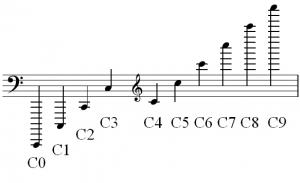Fundamentals
6 American Standard Pitch Notation (ASPN)
Chelsey Hamm and Bryn Hughes
Key Takeaways
- American Standard Pitch Notation (ASPN) provides a label for specific musical frequencies by combining a note name (such as “C”) with a subscript octave designation (such as “4”).
- A pitch is a discrete tone with an individual frequency (e.g. “C4“), while a pitch class is less specific (e.g. “C” in general).
- ASPN differentiates between octaves, from C to B. The octaves are labeled from lowest to highest, beginning with “0” and continuing in ascending numerical order (e.g. “1,” “2,” etc.).
- A piano keyboard primarily uses the ASPN octave designations “1” through “7,” although small portions of octaves “0” and “8” are included.
- Middle C is C4 is in ASPN. This is one note whose ASPN label is helpful to memorize as a starting point.
American Standard Pitch Notation and Pitch versus Pitch Class
In order to discuss specific notes, or pitches, we will use American Standard Pitch Notation, abbreviated ASPN. ASPN designates specific musical pitches by combining a note name (such as “C”) with a subscript octave designation (such as “4”), creating a bipartite label (for example “C4“). ASPN labels are very useful, since they can identify every possible musical note within human hearing range, from the lowest to the highest pitches.
A non-specific pitch is called a pitch class. For example, all Cs are the same pitch class. Any note that is enharmonically equivalent to C, such as D𝄫 or B♯ would also be part of the “C” pitch class. All pitches of the same letter name are said to have octave equivalence if they are one or more octaves apart.
ASPN and Octave Designations
ASPN differentiates between octaves beginning with the pitch “C,” and ending with the pitch “B.” This means that each new octave designation begins on the note “C,” as seen in Example 1:

The octaves are labeled from lowest to highest, beginning with “0,” and continuing in numerical order (“1,” “2,” “3,” etc.). The pitch middle C is C4, which is useful to memorize.
All letter names within an octave receive the same octave designation if they are below the “C” of the next octave. For example, all of the notes in Example 2 would be in the designated in the “4” octave, because they are above C4 but are below C5:

All notes below the note “C” receive the next lowest octave designation, even if they are enharmonic with “C.” For example, The note B# would get the lower octave designation, even though it is enharmonically equivalent with the note “C.” Another way of saying this is that accidentals applied to note do not have an effect on its ASPN number.
ASPN and the Keyboard
ASPN labels are very helpful for finding specific notes on the piano keyboard. Example 3 depicts a piano keyboard with each octave labeled using ASPN notation:

As you can see in Example 3, the piano keyboard spans full octaves one to seven. It also contains a small part of both octaves zero and eight. ASPN labels are the same regardless of instrument or voice type. In other words, a C4 will always be labeled as such regardless of whether it is played on a flute, trombone, violin, or whether it is sung.
ASPN and Staff Notation
The following four examples show ASPN labels for common notes in the treble, bass, alto, and tenor clefs. Example 4 depicts labeled notes in treble clef:

Example 5 shows some ASPN labels in bass clef:

Example 6 depicts ASPN labeled notes in alto clef:

And Example 7 shows some ASPN labels in tenor clef:

As you can see from Examples 4–7, memorizing C4 in each clef can make finding ASPN labels quicker and easier.
- “Pitches, Pitch Classes, Octave Designation, Enharmonic Equivalence” (YouTube)
- Tutorial on ASPN Octave Labels (liveabout.com)
- Tutorial on ASPN Octave Labels (flutopedia.com)
- Helpful Graphic with ASPN Labels on the Grand Staff and Piano (Music Theory Tips)
- Flash Cards with ASPN Labels in Treble and Bass Clefs (quizlet.com)
Designates specific musical frequencies by combining a note name (such as "C") with an octave designation (such as "4") creating a bipartite label ("C4")
Refers to how "high" or "low" a sound is
All pitches that are equivalent enharmonically and which exhibit octave equivalence
Two pitches with the same letter name (e.g. "C"), twelve half-steps apart
C4; the C near the middle of the piano keyboard, written on the first ledger line below the treble clef staff or the first ledger line above the bass clef staff
Discrete tones with individual frequencies
A method of specifying musical pitches by combining note names with octave designations
Notes, intervals, or chords that sound the same but are spelled differently
Pitches that are spelled the same but are one more more octaves apart
A series of eight notes (such as C to C)

